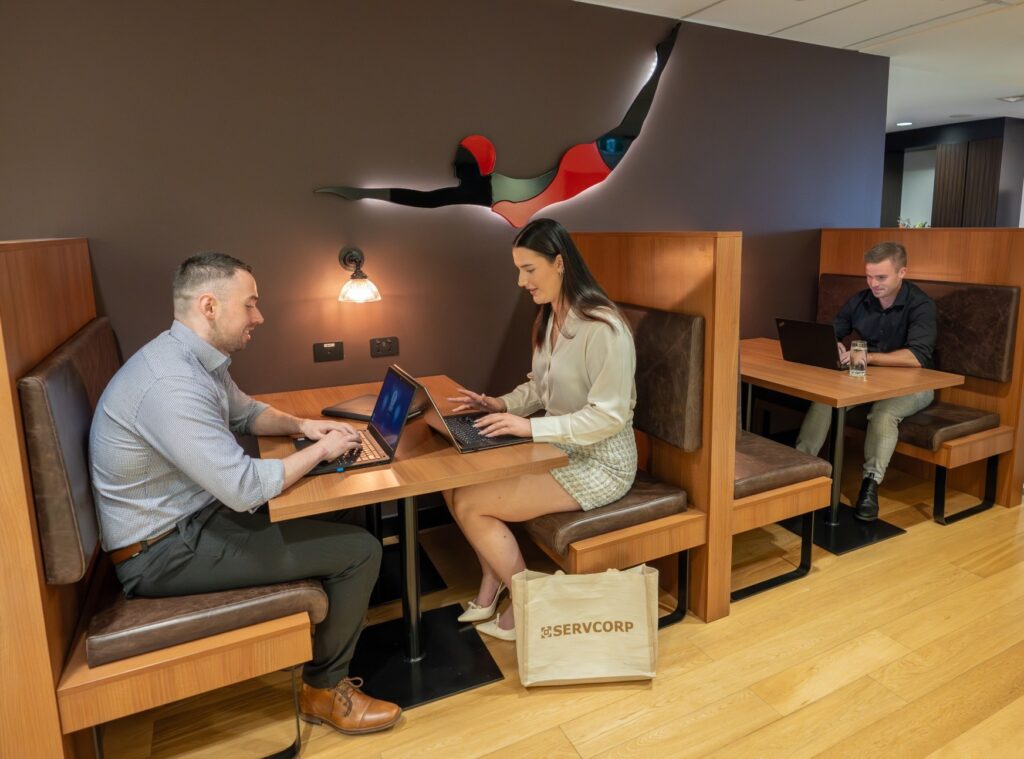The way companies approach office space has undergone a shift. A long-term lease isn’t the default anymore. Coworking is now a serious option for teams at every stage, from early startups to remote-first companies and larger businesses seeking flexibility.
This breakdown looks at how a traditional vs modern office stacks up across cost, setup time, scalability and everyday use. It’s based on fundamental changes happening in cities like New York, London and Singapore, where commercial space is being used in new ways.
If you’re figuring out what kind of space makes sense for your team, or whether a lease still fits your model, this guide lays out the differences between coworking vs traditional office models.
Snapshot Comparison of Coworking vs Traditional Office
Here’s how the two workspace models compare across common business priorities:
|
Factor |
Coworking Spaces |
Traditional Offices |
|---|---|---|
|
Lease Term |
Month-to-month or short contract |
3–10 years typical commercial lease |
|
Pricing Model |
All-inclusive membership |
Separate vendors for rent, services, fit-out |
|
Scalability |
Add/remove seats as needed |
Fixed space regardless of usage |
|
Privacy |
Shared zones with private options available |
Full control over space and layout |
|
Collaboration |
Shared office space encourages interaction |
Siloed unless deliberately designed otherwise |
|
Setup Time |
Ready in 1–3 days |
Weeks to months including fit-out and IT |
Each of these points will be unpacked in the sections below, helping you decide which model fits your team, budget, and business phase.
Cost and Flexibility
Coworking is simple. You pay once a month and get what you need. That usually includes desks, internet, meeting rooms, cleaning and utilities. There’s no need to manage five different service providers or worry about separate contracts. For early teams or companies growing in phases, this removes a lot of extra work.
A traditional office is more involved. Leases often span several years and require upfront deposits. Teams handle their own furniture, IT setup, maintenance and admin. That can work, but it often adds layers that don’t adapt well when plans shift.
In cities like Boston, New York and Miami, coworking often comes out cheaper. A study has shown that coworking memberships can save small teams approximately $95,000 per year. For smaller teams, that difference can make a big impact over the course of a year.
The numbers matter, but so does the ability to move without friction. When space aligns with your budget and momentum, it becomes an integral part of your growth. Unlike traditional office spaces, which can sometimes feel like a liability, this alignment allows for a more seamless experience.
Scalability and Agility
Startups aren’t built in a straight line, and they are highly malleable due to their lower risk capacity. Hiring can move fast one month, then pause the next, or project teams might need extra meeting rooms temporarily.
Coworking spaces are highly agile. They offer monthly leases, and you can add a desk, upgrade to a private office, and adjust your plan based on what’s happening in your business. Traditional offices, by contrast, require forecasting your space needs years in advance. Most leases are fixed, and even subleasing comes with cost and legal complexity.
If your team shrinks or shifts to hybrid, you’re often left paying for empty square meters. And with global average office usage at around 35%, it’s worth considering whether it’s worthwhile.
For established companies, this isn’t an issue and they prefer to maintain the same office space for stability.
Ultimately, one solution doesn’t fit all.
But coworking spaces offer more scalability, agility, and flexible membership options.
Culture and Collaboration
The way a workspace feels can shape how people work. In coworking spaces, the culture often encourages openness. That might happen in the kitchen, during a casual event, or just while grabbing coffee. These positive encounters have a positive mental impact on your everyday routine. Shared spaces make it easier to strike up a conversation or offer help without needing a formal reason.
That kind of interaction adds up. Someone mentions a tool you’ve never tried. Someone else offers a quick thought on your product name. These aren’t scheduled meetings, but they can shift your thinking or solve a small problem at the right time. It’s a unique form of motivation that people experience when surrounded by like-minded professionals.
Traditional offices bring something different. They offer privacy, structure and full control over the environment. For teams that rely on deep focus or who need quiet space to handle sensitive work, that level of separation is valuable. You can build culture intentionally over time, especially if everyone is in the same place most days.
Still, that setup tends to limit outside input. Conversations stay mostly internal. New ideas often need to be pursued, not stumbled upon.
Research published by MDPI shows that coworking spaces support knowledge sharing between people working in different roles or industries. That kind of overlap leads to new ideas, useful intros, and creative problem-solving that might not surface in a more closed setting.
Both models offer something useful. It depends on the work you’re doing and the kind of energy you want in the room.
Infrastructure and Services
Most professionals don’t look past fast internet when considering coworking space infrastructure.
It’s the whole setup that helps your team work without interruption. That means stable Wi-Fi during key calls, meeting rooms that are easy to book when things get busy, and practical tools like mail handling, printing and IT support that don’t need constant attention.
Coworking spaces tend to have that already in place. A single membership often includes internet, shared lounges, hot desks, cleaning, reception services and rooms you can use for meetings or calls. You don’t need to wait for installations or coordinate with multiple vendors. The space is ready when you walk in.
Traditional office space lets you decide how everything runs, but it also asks you to manage every part of the setup. You’ll need to choose an internet provider, furnish the space, set up the IT infrastructure, and take care of ongoing maintenance. That works for some teams, though it can create a steady stream of extra tasks and costs.
For companies without an operations lead – or anyone who prefers to keep things lean – coworking infrastructure fills the gap. The tools are already working in the background, so you can focus on what actually moves the business forward.
Privacy and Customization
Privacy can be non-negotiable, especially when you’re dealing with client work, legal documents or financial data. In a traditional office, you’re in complete control. You decide who has access. You shape the layout, manage sound, and decide what goes on the walls. That kind of setup fits industries where oversight and confidentiality aren’t optional.
Coworking takes a different approach. Most spaces offer private offices, bookable conference rooms, and in some cases, access-restricted areas. It’s enough for solo consultants, small businesses, or teams that need quiet without total isolation. In some premium setups, you can tweak the layout a bit or add subtle branding, depending on your plan.
Each option has limits. A leased office gives you full control but adds layers of setup and ongoing cost. Coworking moves faster, but you’re working within someone else’s framework.
The better fit usually comes down to how much space you need to shape and how much time you have to shape it.
Hybrid and New Workspace Models
Workspace needs are dynamic and don’t follow a single rule anymore. This flexibility has made a lot of companies mix it up depending on their teams. Some keep a core office for leadership, then spread out through coworking memberships in other cities. Others offer local space to remote staff so they’re not always working from home.
This kind of setup works because it leaves room for different rhythms. One person might need a quiet desk three days a week. Another might drop in to meet a client or onboard a new hire. Sometimes a team just needs somewhere real to gather without flying halfway across the country.
Landlords have started shifting too. You’ll see more buildings that offer managed suites alongside coworking floors and shared lounges. These aren’t old-school leases. They’re built around short terms, bundled services, and fewer layers of admin. You still maintain privacy, but you’re not tied to the rest. The contrast between a coworking space vs traditional office is clearest here.
Hybrid models provide teams with more options for adjustment. When budgets change or roles shift, you don’t have to rebuild everything from scratch. You simply move the pieces that need to be moved.
Most teams aren’t trying to eliminate offices. They’re trying to build something that fits their existing workflow. As work patterns continue to shift, the future of coworking spaces will likely include even more tailored setups that blend privacy, flexibility, and tech-enabled design.
Decision Guide: Choosing The Right Workspace Model
The decision between coworking and a traditional lease isn’t always about saving money. It usually comes down to what kind of structure your team needs, how fast things are moving, and what kind of work you’re doing.
A solo founder working odd hours across time zones might only need a flexible desk and a place to take calls. A legal team handling confidential work probably needs tighter control over access, layout and how the space is used.
If you’re weighing the options, these questions can help clarify what makes sense:
-
How often will people be using the space: every day, once a week, a few times a month?
-
Do you need complete control over layout, privacy, or branding?
-
Are you ready to handle utilities, cleaning, and tech setup independently?
-
Will your team remain the same size, or do you anticipate any shifts over the next year?
-
How quickly do you need to be up and running?
When you can, try both. Coworking providers often offer trial days or short-term passes. Some landlords allow tours or pop-up setups so you can get a feel for the space before signing anything.
The ideal coworking space should support your team’s daily rhythm, give room to grow, and feel like an extension of how you work.
Coworking space vs traditional office: which is better for small teams?
For small, fast-moving teams, a coworking space vs traditional office setup offers more flexibility and fewer upfront costs. It’s easier to scale seat by seat and access shared amenities without the commitment of a lease. That said, teams handling sensitive data or requiring full control may still benefit from a traditional space.
What does the future of coworking spaces look like for hybrid teams?
The future of coworking spaces is trending toward hybrid-ready setups. Expect more private suites, day-use passes, and integrated tech tools designed to support distributed teams. Providers are also investing in wellness features and on-demand access for global users
How does a traditional office vs coworking setup impact long-term flexibility?
A traditional office vs coworking setup gives more control but less agility. Traditional leases lock in space for years, while coworking allows for adjustments based on team size, project cycles, or budget. If flexibility is a long-term priority, coworking offers more adaptability.





